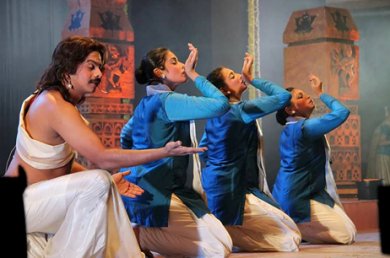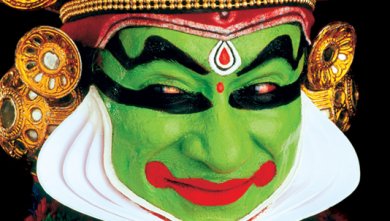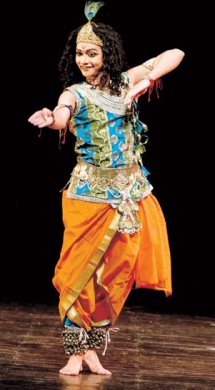
|
 |

|
 |
Aharya Abhinaya - Pallavi Shidhaye e-mail: pallavi.shidhaye@gmail.com April 27, 2019 (Second winner in the junior category in the 'Nrutya Shabda' essay writing competition conducted by Neha Muthiyan's Loud Applause and Swarada Dhekane's Samvaad blog. This is a translated essay.) Aahaaryo Haarkeyur Veshaadibhi: Alankruta An act which is adorned by external accessories like garland, ornaments around the arm and costume is called Aharya Abhinaya. The concept of acting (abhinaya) has its origin from Bharata Muni's Natya Shastra. Acting is an art of expression. Aharya Abhinaya plays a significant part in the classical form of dancing. Abhi is a Sanskrit word and means "leading an audience towards" the experience (bhava) of a sentiment (rasa). Abhinaya can be divided into four categories according to the Natya Shastra: 1. Verbal (Vaachik Abhinaya): Representation of the act through verbal demonstration of literature forms like Kavya (poetry) and Natya (act). 2. Body (Aangik Abhinaya): Representation of the act using different parts of the body. 3. Costumes and Physical Decorations (Aharya Abhinaya): Representation of the act. which is adorned by external things like garland, ornaments around the arm and the costume. 4. Holy or Pious (Saatvik Abhinaya): Reproduction of the act when the body and soul synchronize with each other. Aharya Abhinaya means presenting a character before the audience through the use of costumes, make-up and ornaments. e.g. The traditional character of Krishna is portrayed using a yellow silk dhoti also known as Peetambar, a crown (mormukut), a necklace and a flute. This attire helps to depict the character more effectively. Along with the attire, sound is also used to strengthen the portrayal of the character. Aharya Abhinaya also includes use of sound, light and stage art (Nepathya). It is of two types: 1. Natyadharmi: It is the act which is presented in a distinct style and within the limits of its format. 2. Lokdharmi: This type of act is not bound by anything, but happens through the natural movement of the body. An important aspect of Aharya Abhinaya is the costumes. e.g. The king is depicted through crown and a throne while Lord Shiva is depicted through his long hair, snake around the neck and a half-moon on the top of the head.  A classical dancer normally uses all 4 forms of the abhinaya; however the presentation or performance becomes most effective with the Aharya Abhinaya. e.g. While performing the dance drama Meghadoot which comprised of both Kathak and Bharatanatyam forms of dance, the dancers sported a blue and white costume to depict the Megh (cloud). The stage decoration was according to the needs of the subject. However, use of sounds of thunderstorms, birds, etc. had an enormous positive impact on the audience and it took the production to a different level. Set design (stage decoration), make-up, attire and ornaments are extensively used in dance dramas. This helps the performance to be better. The make-up and attire change as per the situation and the character. For this reason, the Aharya Abhinaya is useful in both the dance and drama.  Kathakali is a classical Indian dance from Kerala. It is a "story play" genre of art, but one distinguished by the elaborately colorful make-up, costumes and face masks that traditionally the male actor-dancers wear. The stage for Kathakali is normally an open ground in front of the temple and the yellow light emerging from the burning thick wick sunk in the coconut oil. The makeup in Kathakali follows an accepted code, which helps the audience easily identify the archetypical characters such as gods, goddesses, male and female demons, saints, animals and characters of a story. Different types of make-ups used in Kathakali are: 1. Pachcha (Green): This is used to portray the noble characters or sages. The white beard represents a divine being, someone with virtuous inner state and consciousness such as Hanuman. 2. Katti: This make-up is used to depict evil characters. It uses green, red and black colors. Sometimes the nose and the forehead are painted in white color 3. Minikku: This make-up with a warm yellow, orange or saffron typifies noble, virtuous feminine characters. 4. Kari: This make-up with red and black colors is used to depict the forest dwellers, hunters, and middle ground characters. Female demons and treacherous characters are also painted black but with streaks or patches of red. The entire make-up process takes around 2 hours and is done with natural colors and rice paste. The attire includes 42 different types of clothing and ornaments.  Kathakali and Kathak both use suggestive Aharya Abhinaya. The make-up style in Kathak is different than that in Kathakali in the sense that it changes according to the attire of the character being portrayed. However, due to the limitation of space and time and the need to perform, the make-up in Kathak has its own limit. Hence, more thrust is given on the Vaachik, Aangik or Saatvik Abhinaya. This poses a challenge to the artists. The artists have been trying out various experiments of Aharya Abhinaya in the Kathak. e.g. School girls participate in Bhajan or Keertan programmes and play the clash cymbal. In one of the recent programmes, an old Marathi film song, 'Ithech taakaa tamboo' was performed using the mix of Kathak and folk dance. The dancers, mainly young girls, were dressed as per the original song. They had used dafali and ghungroo to enhance their performance. All of these had a very good impact on the audience. Through such experiments the Aharya Abhinaya is more effective. The acting and dancing skills of the performing artist adds to the beauty of the overall performance. Thus, I feel that Aharya Abhinaya is a gift to all the performing artists which helps them get the audience connected to or involved in the performance thereby giving him/her the complete satisfaction of watching an exemplary performance! References: wikipedia.org/wiki/Abhinaya kalyanikalamandir.com/blogs/aharya-abhinaya Some references are taken from the theory notes of classical dance forms. Image references: Internet Pallavi Shidhaye is learning Kathak for last 8 years under the guidance of Neha Muthiyan. She has completed her graduation in Architecture from Pune University. Post your comments Please provide your name and email id when you use the Anonymous profile in the blog to post a comment. All appropriate comments posted with name & email id in the blog will also be featured in the site. |